If you were inspecting PV systems before publication of the 2008 NEC, you may have seen some interesting DC combiners (see photos 2 through 6) and other creative electrical field fabrications.
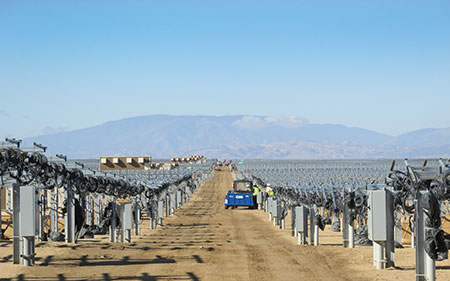
The 2005 NEC Article 690.4(D) Equipment said, “Inverters or motor generators shall be identified for use in solar PV systems.” That’s it! In those days (unless your jurisdiction had an ordinance or supplement to the code requiring product listing/certification), the contractor could point to this section and say listing/certification is not required for their DC combiners. And if needed, all it took was a speed dial to the Building Official, County Supervisor or Mayor along with an allegation that you are not supporting the advancement and evolution of renewable energy, and within an hour the contractor was receiving final signoff of their installation. Luckily, the 2008 NEC added additional language to 690.4(D) to cover many common components to include source circuit DC combiners. Additionally, the 2017 NEC added the term “field labeled” as an option for the installer to achieve some level of compliance acceptable to the local AHJ.
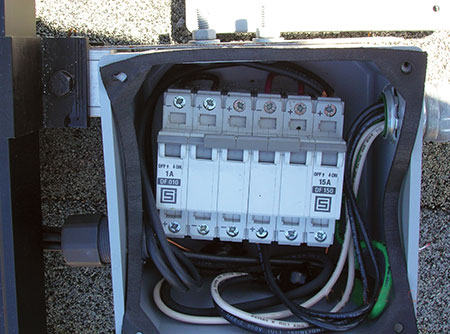
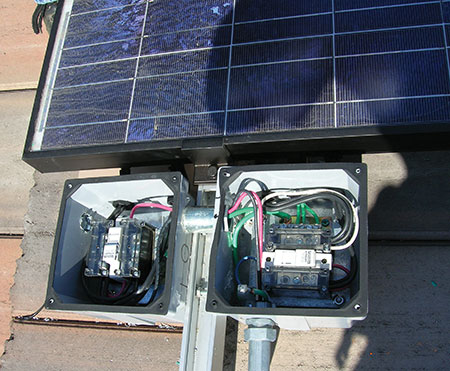
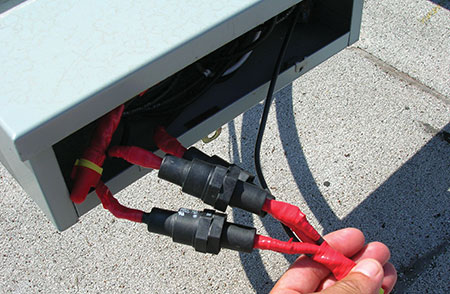

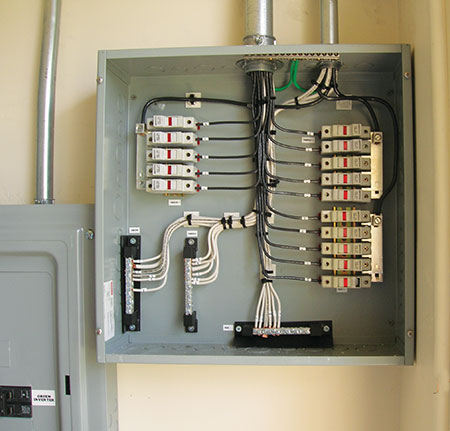
This article will focus on the inspection of DC combiners, tracker controllers and other unique and challenging situations utilizing the NEC, UL Standards, and the Building Code. We will also focus on when a field evaluation is appropriate.
DC Combiners
As mentioned in my July/August issue, DC combiners are being slowly replaced with DC harnesses with inline fuses for ease of installation. However, the tradeoff is serviceability (just try finding a blown fuse in a DC harness), and I predict DC combiners will be around for those who choose ease of servicing and replacement of parts.
The first item of concern on these large-scale projects is to review the installation instructions if they have them. I mention this because I have had several situations over the years where the combiners were “custom” for the project, and the manufacturer and original certifying NRTL could not produce the proper documentation. Now, what do you do? I suggest raising the red flag early on and communicating the issue in writing. You will want to contact in writing the manufacturer and original NRTL for assistance. You might be saying “What’s the big deal? It has a listing mark.” Moreover, this is often the response out in the field from many contractors and AHJs. But the true questions should be, how do you install this? Where are the conduit entry locations? If your conductors are oversized for voltage drop, do you have the appropriate size terminations? Does the termination allow for parallel conductors? These are all good questions to ask the contractor. Or just ask them to please comply with UL Standard 1741 Section 65.2 “Operating and Installation Instructions” and Section 66 “Important Safety Instructions.”
Hopefully, the contractor will be able to produce the appropriate documentation. However, you may see issues with the product construction that clearly do not meet the 1741 Standard, such as:
- The combiner has a multiconductor cable type (10 ft. in length) marked TC-ER that contains no EGC required by NEC 336.10(f) and UL 1741; UL 9703 Section 18.1.2 & 39.2 (see photos 7 & 8).
- The combiner has green paint marks used by the manufacturer for torque verification on all terminals inside the enclosure and is confusing. UL 1741 Section 18.1.13 reserves this color for the field installed EGC.
- The DC harness transitions (after 6 ft.) to a radiator hose used as a cable management system not recognized by the NEC and/or UL Standards.
- The rating nameplate on the combiner is marked with two different maximum fuse ratings, 15A & 30A; additionally, the maximum number of inputs is absent. UL 1741 Section 63.2 requires the manufacturer to list the maximum number of string inputs.
- The nameplate is installed inside the enclosure and is required to be readily visible (outside the enclosure) as required by UL 1741 Section 63.2.
- The installation instructions state a surge suppressor is installed in the unit; however, currently there is no surge suppressor.
- The individual PV string conductors leaving the DC harness (6 ft. in length) are not type marked, which is a violation of Article 690.31(C) – see photos 9 & 10.
- Wiring terminal markings on the manufacturer installed string conductors are absent at input and output terminals, required by UL 1741 Section 63.2.
- Field wiring terminal marking is absent and is required by UL 1741 Section 63.11. Example “Use copper conductors only” or “Use aluminum or copper-clad aluminum conductors only.”
- The ambient temperature marking is absent; and per UL 1741 Section 66.4(j), if the rating is other than 25° C (77° F), the unit shall indicate the new value.
- The date code required by the UL 1741 Standard is handwritten and does not comply with UL 969 as a permanent and suitable label for the intended environment.
- The DC field connections internally (inside the combiner) are not labeled with the DC symbol as required by the UL 1741 Standard Section 63.7.a.
- The external operating handle is not clearly marked ON/OFF as required by UL 1741 Section 63.9.
- A fuse marking indicating the ampere, voltage and DC ratings for replacement is currently missing from inside the unit as required by UL 1741 Section 64.7.
- The combiner has an exposed multiconductor cable type marked TC only and is in violation of NEC 336.10(7)(a) and UL 9703. The absent ‘ER’ designation stands for “exposed run,” which means the cable has met additional crush and impact test requirements required by the UL Standard.
- The DC combiners (600+ total) are listed by an NRTL to UL 508A.
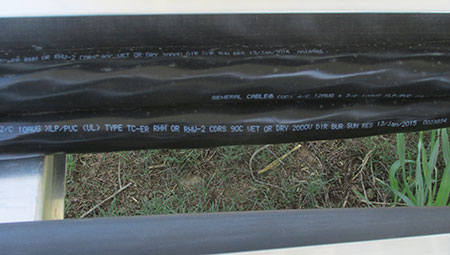
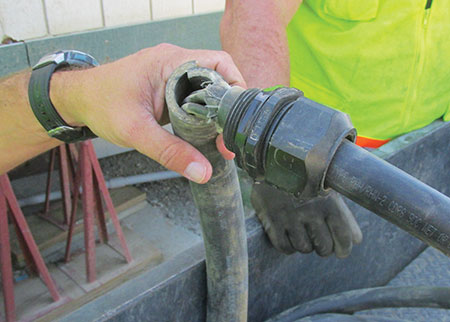

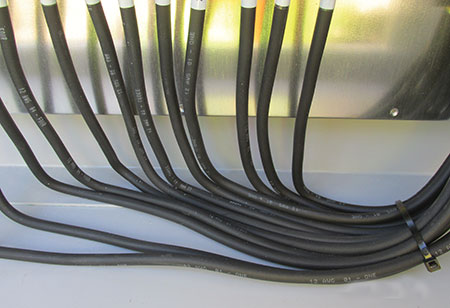
These are all actual violations that were identified during my inspections since 2011, and all were verified as (true) deficiencies by independent third party field evaluation. To date, the deficiency numbers are staggering. Over the years, I have kept track of the number of combiners with deficiencies and so far, I have found 2,905 combiners with codes and standards violations. I continually ask myself, why is this being caught out in the field at this stage of the game? These violations should be discovered during the NRTL certification process or the NRTL follow-up inspections at the manufacturer’s location. Or, are custom products being manufactured by direction of the project/contractor without the certifying NRTL’s knowledge? My answers are best suited for an in-person presentation and go beyond this article. However, stay alert to these issues, and pay special attention to the details, and as I always say, “It’s ok to look inside the box.”
It is especially important to check and look for these issues during your termination inspections. Remember, if you find an issue with the construction of any piece of equipment (not just PV) that clearly does not meet the UL Standard, this should be reported in writing to the certifying NRTL and resolved. I have had occurrences where the original certification NRTL stated nothing was wrong and refused to investigate, which created a situation where another NRTL came in at the contractor’s expense and independently verified there truly was an issue with the construction of the equipment. Keep in mind, these days all of the big players at these sites will have your Building Official’s number on speed dial and will not hesitate to throw you under that virtual bus for writing corrections. I have had personal experience with unpleasant work environments at these sites, where unfounded rumors were spread, ranging from violation of site safety rules to allegations of comments being made about fellow staff — and all of this was done in an effort to replace the inspector. I know I am preaching to the choir, but I just want this to serve as a reminder to mind your Ps and Qs.
Now let’s discuss custom equipment (see photos 11 & 12). This piece of equipment is something of a mystery: is this a 1741 certified combiner or re-combiner? Or maybe it is a DC panelboard that contains 6 breakers (5-250 ADC breakers and 1-200 ADC breakers) to provide the DC disconnecting means for an inverter required by 690.13? The calculations for voltage and current are appropriate, and the equipment appears to be properly rated; however, the door can only be accessed with a screwdriver. UL 1741.13.1(c) says “a disconnect device shall employ an operating handle that is accessible from outside of the enclosure or located behind a hinged cover not requiring a tool for opening.” Additionally, 2017 NEC 690.13(D)(1) requires the disconnecting means to be externally operable (see photo 13). Upon further inspection, it is observed that the bonding conductor to the door is #12 AWG (see photo 14). UL 1741.20.3 allows a metal to metal piano type hinge as a means for bonding a door; however, this door does not have this type of hinge. UL 1741.20.10(a) says this conductor shall not be smaller than the size specified in Column 2 of Table 18.1 (which reads the same as NEC Table 250.122), and a 250 ADC breaker translates to a #4 AWG copper or #2 AWG aluminum conductor, which is a problem. In this case, you would need to decide what course of action is appropriate. You may, possibly, want to have this corrected in the field, but what about the disconnecting means issue discussed earlier? I would recommend contacting the original certifying NRTL and follow-up with a field evaluation by a qualified NRTL to ensure additional items were not missed. You might be surprised.
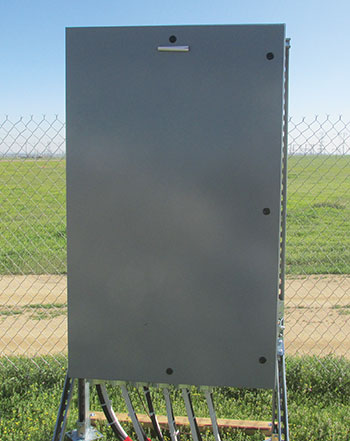
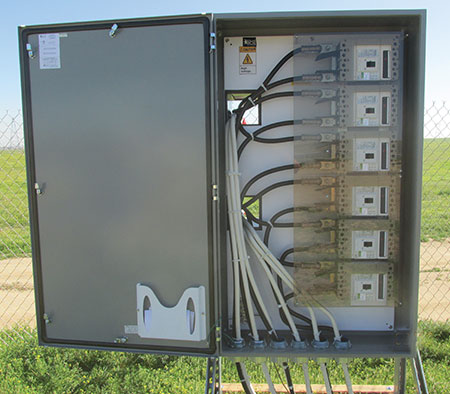
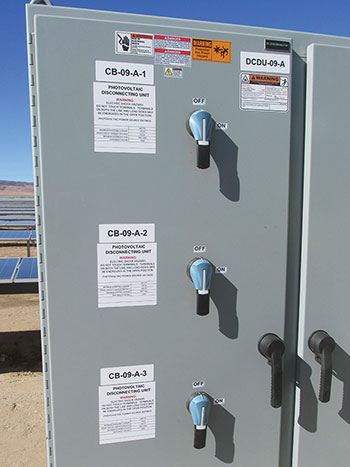
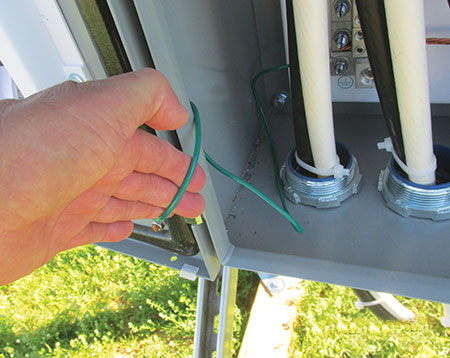
Switchboards
During my walk around the site, I came across an electrician cutting out the bottom of this UL 891 switchboard (see photos 15 through 18). The modification was to provide conduit entry into the bottom of the enclosure, but where are the installation instructions? Is this allowed? As it turned out, we encountered several other deficiencies with this equipment, such as:
- The enclosure was Type marked ‘4X’, but had no NRTL certification mark (red flag).
- The enclosure had an externally mounted heat exchanger with a hood that was not Type rated and had additional mounting holes, possibly requiring an additional UL 50 hose down test to verify Type 4X rating.
- The main nameplate is marked 600 V. However, the switchboards are connected to a 420V, inverter output circuit (3 phase) and include a 480:120 V 200 VA transformer to supply a 120 V heat exchanger (fan). Generally, electrical products are evaluated for use in circuits that deviate not more than +/-10% of the marked voltage rating, which would be a possible violation of UL 891.2.4.2.
- The switchboard has a listed 2000-amp switchboard section installed in an unlisted Type 4X enclosure with no direct ventilation except for the heat exchanger mounted on the back of the enclosure. This installation requires further evaluation to determine if a heat rise test is necessary, UL 891.8.8.1.6.2.
- The switchboard contains a 120 V receptacle and is GFCI protected; however, it is not marked WR Type (required by UL 891.8.6.14.9).
- The 300 V power and control conductors are routed with the 420 V conductors and in contact with the 2000-amp bus, which violates UL 891.8.7.2.3.

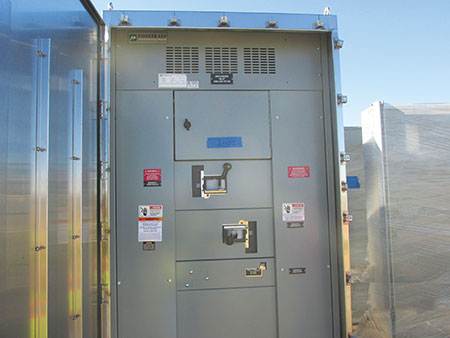
As it turned out, we had 20 units like this which required third-party NRTL field evaluation testing not only for the deficiencies listed above but also for the following:
- Additional field applied hose down test with an 1-1/2 inch diameter fire hose delivering 65 GPM as required by UL 50
- Temperature rise test, current measurements, input test for the fan motor .
This is an example of custom equipment manufactured for a site-specific location that required further evaluation to determine compliance. Our team spent weeks researching this equipment (and others), but ultimately the contractor agreed with the evaluator’s findings.
Weather Stations
Weather stations or meteorological station equipment are used at these sites to monitor weather conditions and are usually part of the purchase power agreement. These usually consist of the following components:
- Sensors for:
- rain
- temperature
- humidity
- solar radiation
- wind speed & direction
- Control panels supplying 120 V and 24 Vdc with:
- battery backup
- solar module to charge battery
As of this writing, I have never seen a properly listed/certified weather station in the field, (see photos 19, 20 & 21). The main issue is that most are assembled under the UL 508A, Standard for Industrial Control Panels. Additional deficiencies are also encountered because UL 61010-1 has not been properly applied. Typically, UL 508A will not cover components mounted remotely or field installed components (see photos 18, 19, & 20). Some common issues encountered include the following:
- The aluminum tower and the aluminum module frame are bonded with a listed grounding clamp marked “for use with copper water pipe.”
- Both control enclosures are non-metallic with metal conduits/FMC attached between enclosures with no bonding bushings to the main EGC location.
- Charge controller, Ethernet/compact flash module, multi-drop interface, and various weather sensors do not appear to be NRTL certified.
- Class 2 power supply is not listed and/or recognized (if it does not say “Class 2” it is no good).
- 24 Vdc output of battery circuit is fused at 5 amps. Table 43.1 requires a 4-amp fuse, 100 VA ÷ 24 V = 4.1 A .
- Control panel is not marked to indicate multiple external sources of power and indicate an internal charge controller/battery that supplies external equipment mounted on tower.
- The wiring diagram attached to the inside cover reads “Class 2”; however, the inspector has already determined the main power supply is not an NEC-compliant Class 2 power supply (so the diagram is deceiving).
- Wiring diagram is absent (see UL 508A.61.1).
- The filtered louver with external shroud, which penetrates through the side of the enclosure for exhaust (ventilation), is not Type rated. The enclosure is required to be dusttight, which limits components opening to Types 3S, 4, 4X (See Table 19.2 (UL 508A) column 2).
- Example: A 4X enclosure with new selector switches/lights installed would need to use recognized components that were appropriately Type rated to maintain my dust type rating (4X rating).
- 120-volt receptacle installed inside the control panel marked 3R requires Class A GFCI protection see UL 508A.28.6.6
- Unlisted ‘two conductor’ cable is routed with and in direct contact with 120-volt conductors (see UL 508A.29.5.1).
- Main nameplate does not comply with UL 508A.52.1, which requires that the nameplate provide complete electrical rating of each supply.
- The installation instructions provided with the enclosure do not match the current model number installed; and as a result, the maximum overcurrent protection for the cooling unit is unable to be determined.
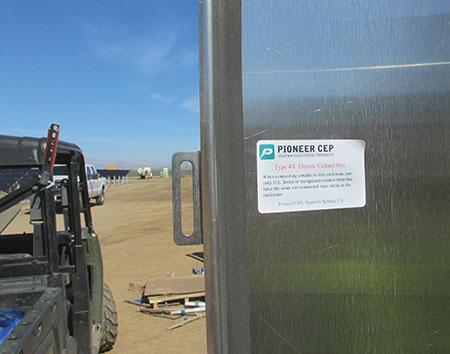

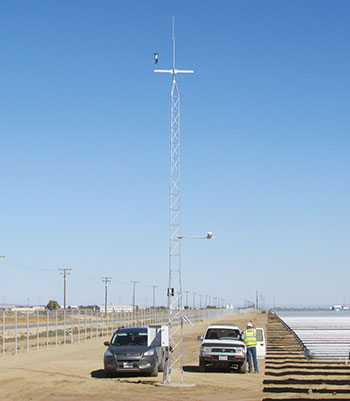
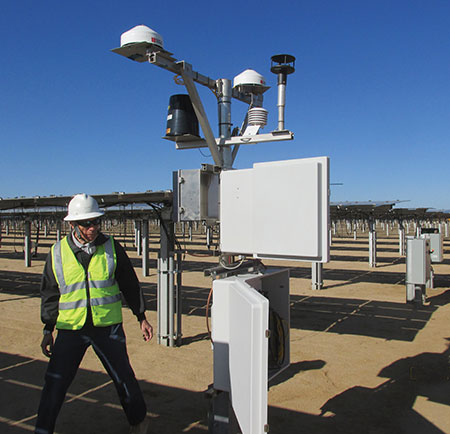
This document is just a sampling of what you may encounter in the field; and these are actual corrections of improperly listed/certified equipment.
Tracker Controllers
Tracker controllers should be listed/certified to UL 3703. However, I have seen controllers NRTL listed to UL 1740 (Standard for Robots and Robotic Equipment) and UL 61010-1 (Safety Requirements for Electrical Equipment for Measurement, Control, and Laboratory Use). If you go to the UL website http://ulstandards.ul.com/standards-catalog/?pagesize=1302 , you will see neither of these standards is appropriate to list and/or certify this equipment. Over the years, the total number of controllers I have found with codes and standards deficiencies (shipped by three different manufacturers) is in the thousands or 275.5 MW spread over three projects. The list of deficiencies is too long for this article. However it is extremely important to look inside the box to ensure a safe assembly that is free from shock and fire hazards. Some things to consider:
- Are all the cables properly rated?
- I have seen control cables for limit switches with no conductor markings
- Is there proper separation between 30-volt conductors and 480-volt conductors?
- Is the motor starter wired correctly?
- Is there a functioning E-Stop? (I have found many without E-Stops)
- Is the controller listed/certified to the correct UL Standard?
- You would be surprised how many are listed/certified to the wrong Standard
- Is the wiring diagram affixed to the inside cover appropriate and correct?
- Are replacement fuse markings present and depict appropriate voltage and current ratings?
This article is just a snapshot of issues summarized in my daily reports. Remember any deficiencies encountered for listed/certified equipment should be subject to a field evaluation by a qualified NRTL before any corrections are made. So always indicate this on your correction notice to avoid any confusion. Written notices and photos are extremely important in documenting the deficiencies. I have had personal experiences where I pointed out labeling deficiencies by the manufacturer one day, only to return the next day to find new labels affixed or new components installed with no justification for the modification. And no one seems to know how it happened… Really? Having a camera during inspections with an imprinted date stamp is a critical tool to have when the finger pointing starts.
These controllers will operate anywhere from 24 volts DC (standalone) to 480 volts AC and are required to have a readily visible E-STOP that is red in color with a yellow background, requires manual resetting, and is unguarded. This E-STOP shall remove all drive power, cause all moving parts to stop, and override all other controls. If there is more than one controller, each controller shall have a functioning E-STOP (see photos 22, 23 & 24). Additionally, all the gear drives, drive shaft motors, additional controllers, and limit switches are required to be included (rolled up) in the overall listing/certification under UL 3703.
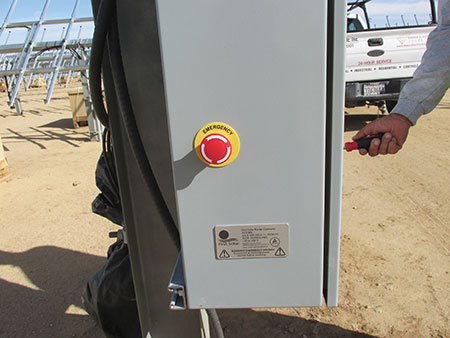
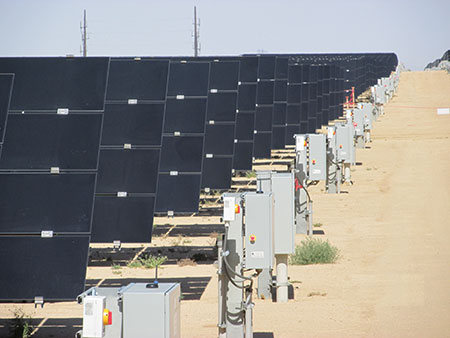
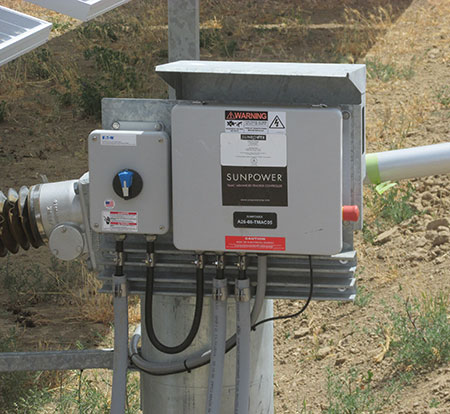
Some unique controls you may run across include ultrasonic flood/snow sensors used to detect flash floods and snow events to place the tracker into a stowed position or move the tracker to sluff snow buildup. Remember, some systems may be in FEMA flood zones, which may require all the equipment to be 2 or more feet above finished grade to avoid equipment damage during flood events. This also means the modules need to be above the 2-foot requirement even when the tracker is at its maximum tilt angle. As an example, the distance from the modules to the ground is different when the modules are stowed at 0 degrees horizontal versus 60 degrees’ maximum tilt in the morning and before sunset. Plan reviewers will need to make sure this is detailed on a drawing depicting the actual distance from the ground at maximum tilt if you are entertaining the use of these ultrasonic devices. Snow depth sensors are used to measure snow depth to sluff snow from tracking module structures that don’t meet the minimum snow loads of the IBC. That’s right; based on the design, these engineers work outside the box to make their systems meet the spirit of the code (I’m smiling as I think “Sounds like another article.”) These sensors measure the distance with an ultrasonic pulse that travels to the target (ground) and uses an air temperature measurement to compensate for the distance measured. Just like modules, sound is temperature dependent; and the hotter the air, the faster the sound will travel. (I am sure that retired Air Force guy John Wiles is cringing at my physics explanation). A microcontroller calculates this temperature compensated distance using an analog signal between 0 and 5 volts, all configurable using internal dip switches. Again, since these components are performing a critical function in ensuring the survivability of the tracker system during an event, these components should be part of the overall listing/certification of the system under UL 3703. Moreover, you may want a demonstration (function test) to see if these safety features work.
Summary
As you can see, plenty can catch the eye when you are inspecting these large-scale PV systems. You just have to know what to look for. Not enforcing the minimum requirements of the codes and standards appropriately could lead to the failure of our electrical infrastructure, which we all depend on in our daily lives. As a friend of mine once said, “If we are not careful, we will end up like many third-world countries with substandard buildings and electrical systems.” That is the last thing any of us want. We all want American workmanship and materials to be known for quality and safety. However, it starts with us, the inspectors, to make sure that we can recognize deficiencies in order to safeguard our communities from unsafe and unreliable power sources.
If this article has generated any additional questions and/or comments, please contact the author by phone 619-318-7310 or email at shinspections.inc@cox.net











Find Us on Socials